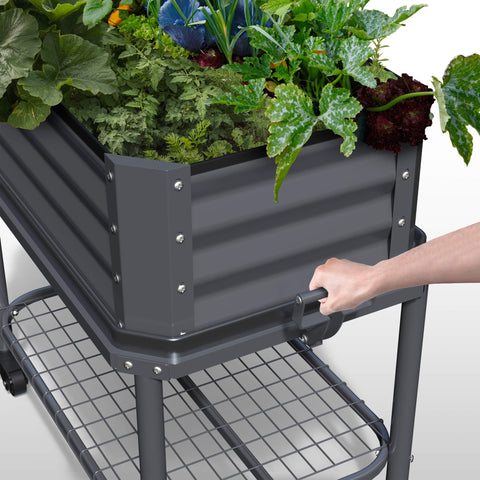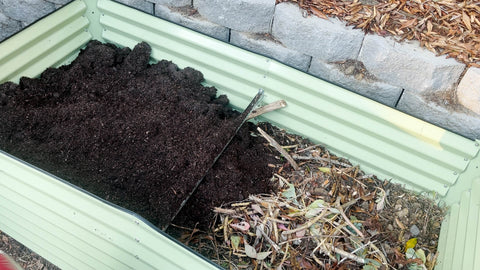Raised garden beds are a popular planting method that not only provides an aesthetically pleasing view, but also better soil drainage and a more manageable planting space. Whether you are an experienced gardening enthusiast or a novice who has just stepped into the world of planting, this article will provide you with a guide on how to build a raised garden.The following content also has some reference value for raised garden beds
Step 1: Choose the right location
Choosing a location with plenty of sun exposure and good drainage is the key to building a raised garden. In general, most vegetables and flowers need at least six hours of sunlight a day to fully grow and bloom. Also, make sure the site is not in the thick shade of trees so as not to affect the growth of plants.
Step 2: Determine the size and shape
Determine the size and shape of your raised garden bed based on your needs and the size of the space. Often, a smaller garden area is easier to manage, while a larger garden can provide more space for planting. The shape can be square, rectangular or whatever you like, but make sure you have easy access to every part of the garden for planting and management.

Step 3: Choose the right material
Choose materials that are durable and suitable for outdoor use to build a raised garden bed. Common materials include wood, stone, brick and concrete. Make sure the material you choose will not cause harmful chemical reactions to the soil and will be able to withstand the weight of the soil and water your garden needs. In addition, choose materials that do not contain substances harmful to plants to ensure the healthy growth of vegetables and flowers.
Step 4: Create a raised garden
Here is a simple step to create a raised garden:
Clean and prepare selected locations to remove weeds and other obstructions.
Build the boundaries of the garden according to the materials and dimensions chosen. If you choose to use wood, make sure to use wood that is treated with preservatives to extend its service life.
Use insect nets or grass film in raised gardens to prevent weeds from growing.
Fill the bottom of the garden with about 15 cm of coarse aggregate to provide drainage and prevent soil silting.

Add a soil mixture to the coarse aggregate. It is best to choose soils rich in organic matter, such as leaf rot, humus and compost. Make sure the soil is evenly distributed and well moistened.
Step 5: Plant and manage
Once your raised garden is complete, it's time to start growing your favorite vegetables and flowers. Here are some key points to managing an enhanced garden:
Water regularly to keep the soil moist, but avoid overwatering.
Fertilization is essential. Use organic fertilizers to provide the nutrients your plants need.
Prune and weed regularly to keep the garden tidy and ensure that plants have enough room to grow.
Pay attention to the growth of the plant, and promptly deal with any pests and diseases.

Conclusion:
By following the steps above to create an raised garden, you will be able to create a beautiful and efficient planting space. This way of growing not only provides you with an abundance of vegetables and flowers, but also allows you to enjoy the pleasure and satisfaction of gardening. Get started and create your own raised garden!
Step 1: Choose the right location
Choosing a location with plenty of sun exposure and good drainage is the key to building a raised garden. In general, most vegetables and flowers need at least six hours of sunlight a day to fully grow and bloom. Also, make sure the site is not in the thick shade of trees so as not to affect the growth of plants.
Step 2: Determine the size and shape
Determine the size and shape of your raised garden bed based on your needs and the size of the space. Often, a smaller garden area is easier to manage, while a larger garden can provide more space for planting. The shape can be square, rectangular or whatever you like, but make sure you have easy access to every part of the garden for planting and management.

Step 3: Choose the right material
Choose materials that are durable and suitable for outdoor use to build a raised garden bed. Common materials include wood, stone, brick and concrete. Make sure the material you choose will not cause harmful chemical reactions to the soil and will be able to withstand the weight of the soil and water your garden needs. In addition, choose materials that do not contain substances harmful to plants to ensure the healthy growth of vegetables and flowers.
Step 4: Create a raised garden
Here is a simple step to create a raised garden:
Clean and prepare selected locations to remove weeds and other obstructions.
Build the boundaries of the garden according to the materials and dimensions chosen. If you choose to use wood, make sure to use wood that is treated with preservatives to extend its service life.
Use insect nets or grass film in raised gardens to prevent weeds from growing.
Fill the bottom of the garden with about 15 cm of coarse aggregate to provide drainage and prevent soil silting.

Add a soil mixture to the coarse aggregate. It is best to choose soils rich in organic matter, such as leaf rot, humus and compost. Make sure the soil is evenly distributed and well moistened.
Step 5: Plant and manage
Once your raised garden is complete, it's time to start growing your favorite vegetables and flowers. Here are some key points to managing an enhanced garden:
Water regularly to keep the soil moist, but avoid overwatering.
Fertilization is essential. Use organic fertilizers to provide the nutrients your plants need.
Prune and weed regularly to keep the garden tidy and ensure that plants have enough room to grow.
Pay attention to the growth of the plant, and promptly deal with any pests and diseases.

Conclusion:
By following the steps above to create an raised garden, you will be able to create a beautiful and efficient planting space. This way of growing not only provides you with an abundance of vegetables and flowers, but also allows you to enjoy the pleasure and satisfaction of gardening. Get started and create your own raised garden!









